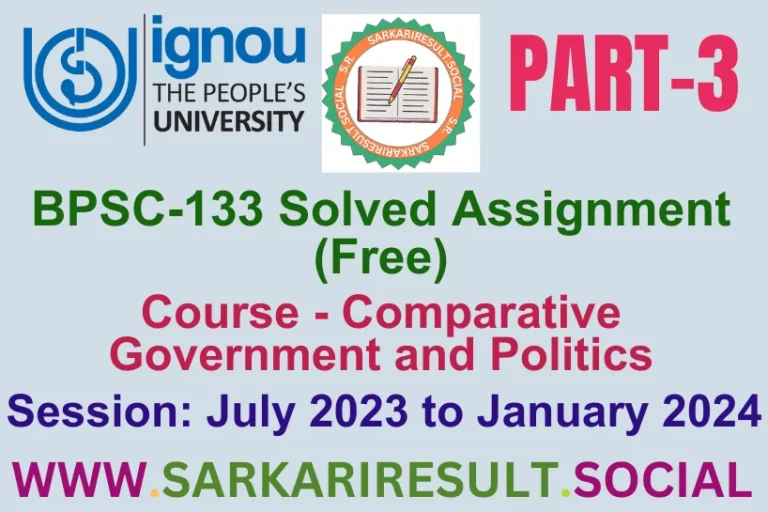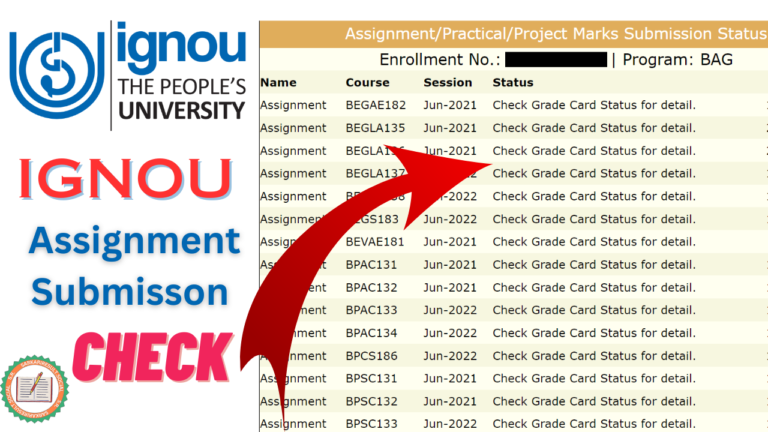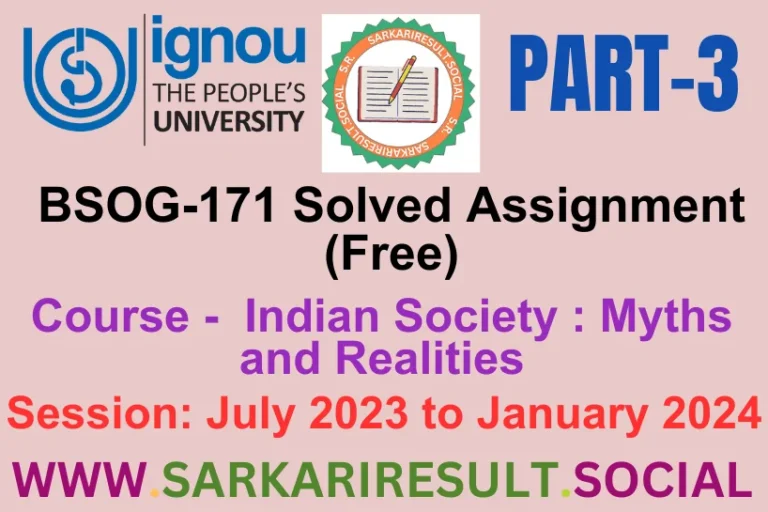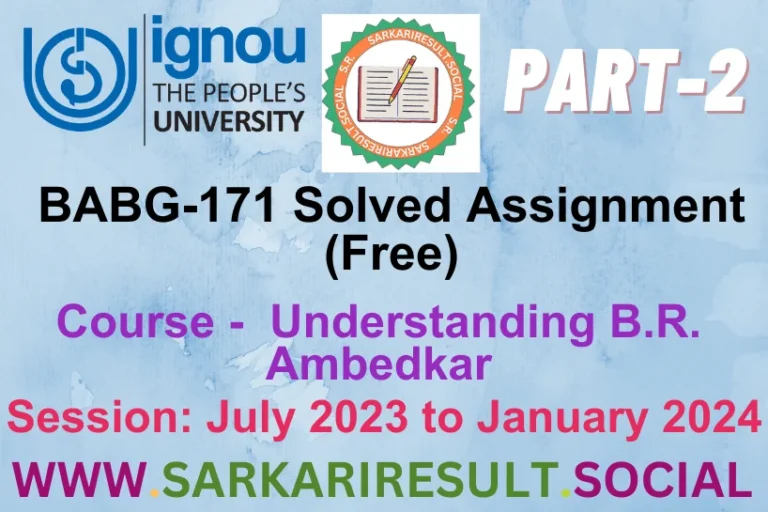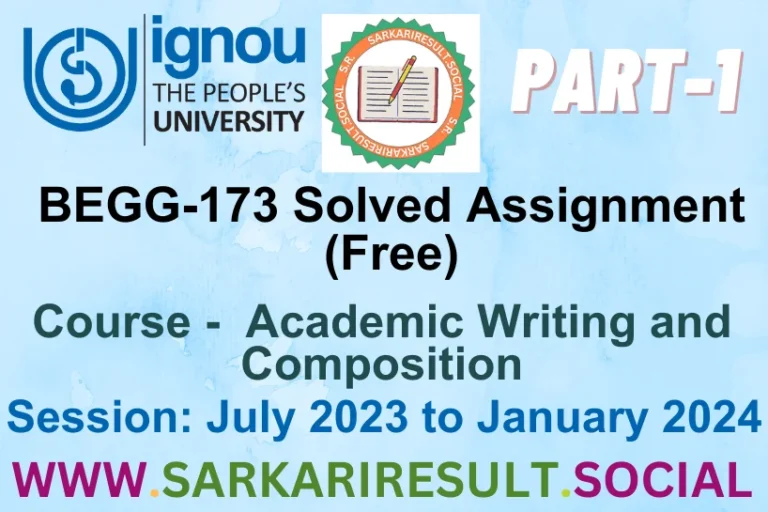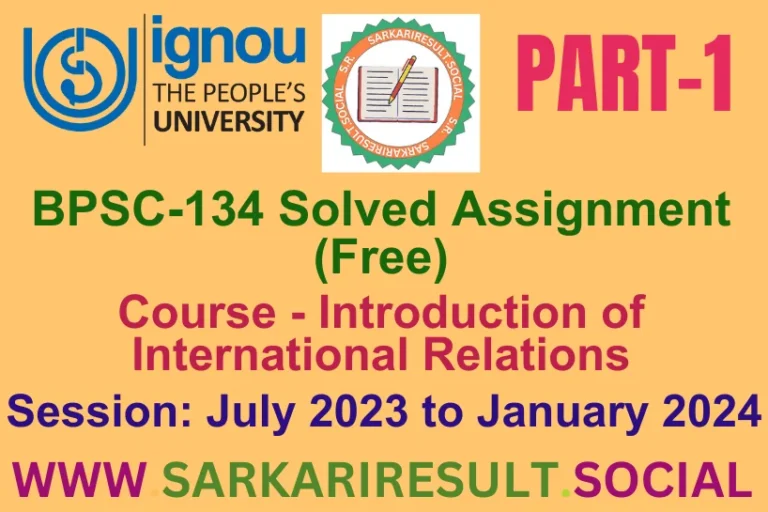BPCG 174 SOLVED IGNOU ASSIGNMENT FREE PART 1
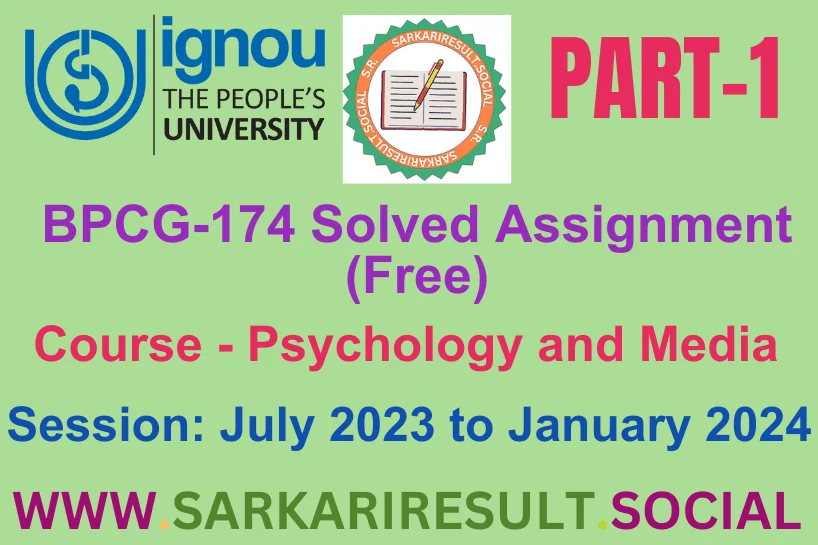
Welcome to the BPCG 174 SOLVED IGNOU ASSIGNMENT FREE PART 1 TMA. Assignment One sets the stage for your success with two thought-provoking questions. In approximately 500 words each, explore the multifaceted role of media as a teaching aid and dissect the impact of negative influences of media on human development. Our IGNOU Solved Assignments 2024 for this section serve as your creative guide.

Answer the following questions in about 500 words each.
Q.1 Explain the use of media as a teaching aid.
Ans. The use of media as a teaching aid is a dynamic and impactful strategy that enhances the learning experience by integrating various forms of media into educational practices. Media, in the context of teaching, refers to a range of visual, auditory, and interactive tools, including but not limited to videos, images, podcasts, presentations, and online resources. Here’s an exploration of how media serves as a valuable teaching aid:
1. Enhancing Engagement:
– Media captures students’ attention and makes learning more engaging. Visual aids, videos, and interactive content stimulate interest, cater to diverse learning styles, and maintain focus.
2. Facilitating Understanding:
– Complex concepts are often better explained through visual representation. Diagrams, charts, and animations aid in simplifying abstract ideas, making them more accessible and comprehensible to students.
3. Supporting Multimodal Learning:
– People have different learning preferences—some are visual learners, others auditory, and some kinesthetic. Media as a teaching aid accommodates these differences by providing a variety of formats, allowing students to engage in ways that suit their learning style.
4. Fostering Real-World Connections:
– Media exposes students to real-world applications of theoretical concepts. Educational videos, documentaries, and simulations bring learning beyond the classroom, connecting theory to practical scenarios.
5. Encouraging Critical Thinking:
– Media prompts students to analyze, critique, and evaluate information. Incorporating media sources challenges students to think critically, fostering analytical skills crucial for their academic and professional development.
6. Promoting Collaboration:
– Online platforms and collaborative tools enable students to work together irrespective of physical locations. Media facilitates group projects, discussions, and knowledge sharing, enhancing collaboration among students.
7. Personalizing Learning:
– Media allows educators to tailor content to individual needs. Online platforms often offer adaptive learning features, providing personalized learning experiences based on students’ progress and preferences.
8. Providing Accessibility:
– Digital media provides flexibility and accessibility, accommodating diverse learners, including those with disabilities. Captions, transcripts, and other assistive technologies enhance inclusivity in educational settings.
9. Keeping Content Current:
– Media enables educators to update and deliver the most recent information. Online articles, podcasts, and videos allow instructors to integrate the latest research and developments into their teaching materials.
10. Cultivating Digital Literacy:
– In today’s digital age, competence in navigating and utilizing various media forms is essential. Integrating media into education helps students develop digital literacy skills, preparing them for a technology-driven world.
11. Increasing Motivation:
– The use of engaging and interactive media elements tends to increase students’ motivation to learn. Well-designed educational games, simulations, and multimedia presentations tap into students’ intrinsic motivation, fostering a positive attitude toward learning.
12. Flexibility in Delivery:
– Media allows for asynchronous learning, providing flexibility in content delivery. Recorded lectures, online resources, and multimedia materials enable students to access learning materials at their own pace and convenience.
13. Assessing Progress:
– Media can be integrated into assessment strategies. Online quizzes, interactive simulations, and multimedia projects provide alternative assessment methods, offering a more comprehensive understanding of students’ progress.
In conclusion, the use of media as a teaching aid enriches the educational experience by catering to diverse learning styles, promoting engagement, and providing a bridge between theoretical concepts and real-world applications. As technology continues to evolve, incorporating various forms of media into educational practices becomes increasingly essential for fostering a dynamic and effective learning environment.
Q.2 Discuss the role of negative influence of media on human development.
Ans. The negative influence of media on human development has become a growing concern in contemporary society. While media can be a powerful tool for education and communication, its detrimental effects on individuals, particularly during crucial stages of human development, cannot be ignored. Here’s an exploration of the role of negative media influence on human development:
1. Body Image and Self-Esteem:
– Media often perpetuates unrealistic beauty standards, promoting a narrow and idealized portrayal of body images. Exposure to such imagery, especially through social media, can contribute to body dissatisfaction and low self-esteem, particularly among adolescents susceptible to societal pressures.
2. Violence and Aggression:
– The media, including movies, video games, and news coverage, often sensationalizes and glamorizes violence. Prolonged exposure to violent content has been linked to increased aggression, desensitization to violence, and a normalization of aggressive behavior, particularly in children and adolescents.
3. Social Comparison and Envy:
– Social media platforms contribute to a culture of constant comparison. Individuals may feel inadequate when comparing their lives to the curated and often embellished representations on social media, leading to feelings of envy, anxiety, and diminished well-being.
4. Cyberbullying:
– The rise of online interactions has also brought about the negative phenomenon of cyberbullying. Social media platforms and online forums can be breeding grounds for harassment and bullying, causing significant emotional distress and affecting the mental health of victims, often children and teenagers.
5. Deterioration of Real-Life Relationships:
– Excessive use of social media and online communication can lead to the deterioration of face-to-face relationships. Individuals may spend more time engaging with digital interactions, impacting the development of crucial social skills and the ability to form deep, meaningful connections.
6. Desensitization to Risky Behaviors:
– Media portrayal of risky behaviors, such as substance abuse and unsafe sexual practices, can desensitize individuals to the potential consequences of these actions. This desensitization may contribute to engaging in risky behaviors, particularly among adolescents.
7. Misinformation and Distorted Worldviews:
– Media, including news outlets and online platforms, can spread misinformation, contributing to distorted worldviews and perceptions. Exposure to biased or inaccurate information can influence individuals’ beliefs, attitudes, and decision-making processes.
8. Overemphasis on Consumerism:
– Advertisements and media content often encourage materialism and consumerism. Constant exposure to messages promoting the acquisition of products for happiness and success can lead to a shallow understanding of fulfillment and contribute to unsustainable consumption patterns.
9. Sleep Disruption:
– Excessive use of electronic media, particularly before bedtime, can disrupt sleep patterns. The blue light emitted by screens interferes with the production of melatonin, impacting the quality and duration of sleep, which is crucial for cognitive and emotional development.
10. Reduced Physical Activity:
– Sedentary behavior associated with prolonged media use contributes to reduced physical activity levels. This can have detrimental effects on physical health, leading to issues such as obesity and related health concerns, particularly in children and adolescents.
11. Normalization of Substance Use:
– Media often portrays substance use in a normalized or glamorous light. This can contribute to the normalization of alcohol and drug use, influencing attitudes and behaviors, especially among impressionable audiences.
12. Impact on Academic Performance:
– Excessive screen time and media consumption have been linked to poorer academic performance. Constant distractions, multitasking, and reduced attention spans associated with media use can hinder effective learning and intellectual development.
In conclusion, the negative influence of media on human development encompasses a range of psychological, social, and physical impacts. Addressing these concerns requires a collective effort involving media literacy education, responsible media practices, and awareness campaigns to mitigate the adverse effects and foster a healthier media environment for individuals at all stages of development.
Also See This: BPCG 174 SOLVED IGNOU ASSIGNMENT FREE PART 2

